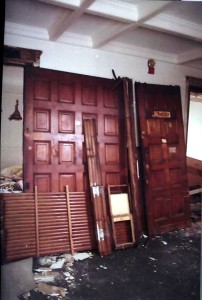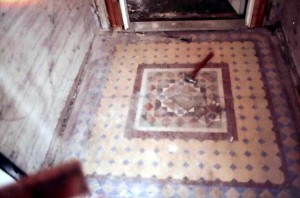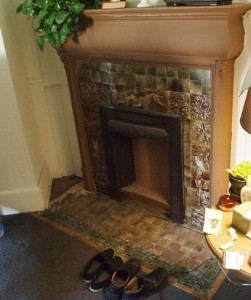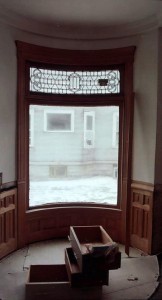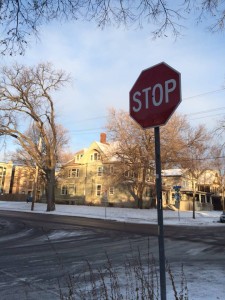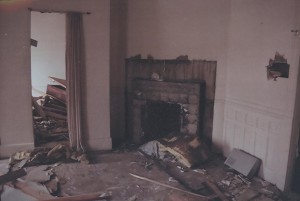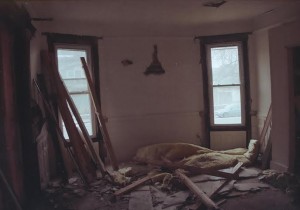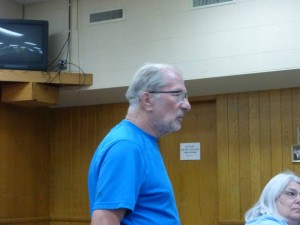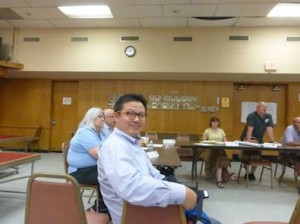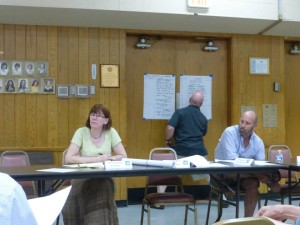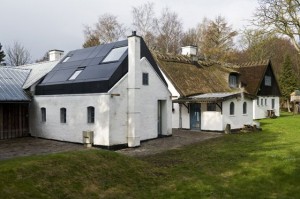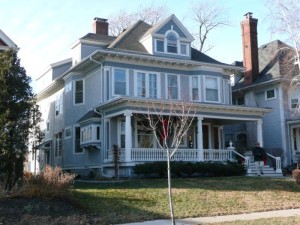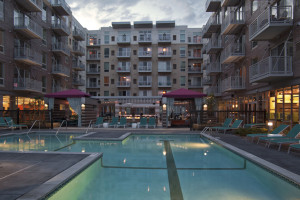
Welcome to the
Healy Project
Join us on Facebook
Send us an Email
Healy Phoenix #1
NOTE: This is the first in a series by the owner describing step-by-step the restoration and repair of the damage incurred in a fire in a Healy House. T.B.
* * * * *
26 August 2015
It is just over a month since the fire in the kitchen of our 1890’s Healy House.
At about 2 am on a Monday morning we were awoken by our smoke detector. There was smoke everywhere. We ran down the stairs, my wife with her cell phone in hand calling 911. While opening the back door in anticipation of the fire fighters needing to get into the house, I saw flames in our kitchen. Everyone got out of the house in plenty of time and the fire trucks (five plus a command vehicle and an ambulance) arrived and they were inside with a house, with a hose, within 5 minutes.
The fire damage was limited to the kitchen, but there was smoke throughout the house. The kitchen will need to be gutted and maybe the bedroom above it. For the preservation side, the kitchen was the most altered room and had very few original features. The effect on the rest of the house is limited to smoke damage and some exterior storm window destruction by fire fighters to allow for ventilation. The fire fighters did a great job and were very kind and helpful. They did tell us that the kitchen’s tin ceiling probably prevented the flames getting to the second floor.
Over the next few months I will be going over this experience: insurance people and friends; cleaning clothing and cleaning electronics; anger and loss; but mostly the kindness and understanding of others.
What a difference two weeks makes. Earlier this month, a salvage company began removing architectural components of the Healy house at 2320 Colfax Avenue South in preparation for its demolition. The number of architectural items that came out of that house stunned even those of us who had never believed that nothing was left of Healy’s original 1893 house: fireplaces, doors, millwork, tiles, stained and leaded glass. The items salvaged are now for sale on City Salvage & Antique’s web site, marketed for the exquisite art they are, worth a small fortune.
A subcontractor of City Salvage on December 5 reported: “They wisely got the glass out first. They were busy tonight removing the raised-panel cherry wainscoting from the entry hall and stairs. The oft-discussed original first floor front facade is in fact still there, hiding inside the enclosed porch. Bay windows and bow window side by side, both intact inside and out. They also found a covered ox-eye window on the north wall of the second floor.
All the large doorways communicating 2320’s entry hall, parlors and dining room, each of which had been filled in with drywall and cheap hollow interior doors [by owner Mike Crow], were found still to have 6′-wide, paneled sliding doors hanging intact in their pockets. The Healy signature tile floor uncovered in the vestibule is being removed, destined for re-purpose as a table top.”
These are all things that demolition proponents, including the developer, the owner’s broker, and two preservation experts, claimed repeatedly weren’t there– before the neighborhood association, the Heritage Preservation Commission, the Minneapolis City Council, and, under oath, before District Court.
Photos and video taken on the second floor of 2320 last week and presented in District Court shows that owner Michael Crow gave misleading testimony, repeatedly claiming that the second and third floors were gutted in the reconstruction after the fire in 1991. The details revealed by the salvage operation show his claims to be false. Tom Dunn (real estate broker) of Terra Firma Commercial, the Lander Group (developer), Amy Lucas (historic preservation expert), and City Planner John Smoley all repeated this false testimony. Did they know it to be false or did they fail to do their due diligence?
Anders Christensen and Trilby Busch went on record 43 years ago (November 1981 Twin Cities Magazine article Legacy of a Master Builder) contending that 2320 Colfax is an important part of Healy’s architectural legacy. This claim was made long before the house was threatened with demolition.
In April of 2013, owner Michael Crow told the Minneapolis Heritage Preservation Commission that “everything on the second floor was completely gutted. . .There just isn’t much of the house left.”
Smoley repeated Crow’s misleading testimony: “The interior has been completely lost.” Lucas echoed this, saying, “I don’t know if any of you have been in the house but when it burned, the second and third floors burned completely. So they were rebuilt as small rooms upstairs, so there are sheet rock walls and metal doors.” Dunn summed up these comments with, “There just really isn’t anything worth saving in the building.” Despite these assertions, the HPC declared 2320 an “historic resource.” In May of 2013, the City Council upheld this decision.
However, after the 2013 election, Michael Crow came back to City Hall singing the same tune, but this time to more receptive ears. In March 2014 on a motion by chair Lisa Bender, the Zoning and Planning Committee granted Crow a demolition permit for an historic resource.
Last May, the Healy Project filed suit in District Court to stop the demolition of this historic resource. The case never made it to the trial stage. The Healy Project failed to get a temporary restraining order (TRO) in large part because Crow, Dunn, Smoley, and Lucas once again repeated the false claims initiated by Michael Crow. Since then, the suit has remained on the docket, minus an injunction against demolition.
After the recent revelation that the vast majority of the interior and exterior of the house was intact, the Healy Project decided to revisit the lawsuit. On Friday, December 19th, attorney Erik Hansen appeared in District Court before the Hon. Frank Magill, Jr. to request a TRO, based on the documented revelations of the salvage operation.
Bethany Gladhill, a credentialed expert on historic preservation, testified that in her professional opinion 2320 would be eligible for listing in the National Register of Historic Places, especially if it were included in a Multiple Property Listing of Healy houses in Lowry Hill East. She called 2320 a “transitional” Healy house, in fact, the “lynchpin” in that transition of designs. In her opinion, 2320 has strong integrity of place, of workmanship, and of materials. She respectfully disagreed with several of the findings and the conclusion of Amy Lucas’s report.
Michael Crow’s attorney Steven Harris said the closing between Michael Lander’s development company and Crow is set for Tuesday. It will be Michael Lander’s responsibility to demolish 2320 and the neighboring house at 2316. Crow will receive $950,000 for both properties; Harris requested a bond in that amount if the TRO is granted. A ruling is expected on Monday, December 22nd.
Did Crow lie to his attorney, or did his attorney lie to the judge in expectation of getting a $950k bond in case the judge issued the TRO? Or is there another explanation of these conflicting reports? Did the closing actually take place on the 22nd? Inquiring minds want to know. T.B.]
The next two posts provide detailed documentation of the series of misrepresentations in the testimony of Crow, Dunn, Lucas, Smoley, and the Lander Group throughout the two-year-long series of hearings regarding 2320 Colfax.
“There is only a negligible amount of original trim inside, which is really not worth saving, there’s nothing special about it.” Tom Dunne, President, Terra Firma Commercial, Real Estate Services
“Fires in 1991 and 2011 have left very little interior fabric.” Amy Lucas, Principal, Landscape Research
“Over 75% of the original materials in the home have been replaced due to extensive fires and insensitive remodeling.” Lander Group Development Team, submitted by Collage Architects.
If the above evidence doesn’t convince you that this whole process was poisoned from the start, here are some more statements presented to decision-making bodies, courtesy of Brian Finstad:
“There is not one single room that is in its original state. The only two rooms that are the most intact in the entire building are the foyer or entry and the original living room with fireplace.”
– Mike Crow – Colfax Addendum – 8 Jan 2014
“Besides some wood door frames there is little original fabric at the interior.”
– Amy Lucas, Landscape Research – Report to Pete Keely – 14 Dec 2012
“The interior has been completely lost with the rooming house conversion and fire repairs.”
– Amy Lucas, Landscape Research – Report to Pete Keely – 14 Dec 2012
“Fires in 1991 and 2011 have left little interior fabric . The second and third floors have been completely rebuilt”
– Amy Lucas, Landscape Research – Report to Pete Keely – 14 Dec 2012
“As is common knowledge, the property has endured a number of fires throughout its history with the last fire essentially removing the upper two floors.”
– Assessment of Economic Feasibility of Rehabilitation – Tom Dunn, Terra Firma Commercial – undated
“There is only a negligible amount of original trim inside, which is really not worth saving, there’s nothing special about it. There is one noteworthy concave window on the north side that will be saved, along with a fire place and whatever else there is of value.”
– Assessment of Economic Feasibility of Rehabilitation – Tom Dunn, Terra Firma Commercial – undated
“… the home is nothing close to the original construction. Over 75% of the original materials in the home have been replaced due to extensive fires, and insensitive remodeling.”
– Letter to HPC – Lander Group Development Team; Collage Architects – 17 Feb 2014
“Nearly all of the construction above the first floor and most of the first floor are not Healy constructed components as these have all been replaced… The second and third floors of the structure were gutted down to the studs… nearly all architectural integrity was removed from these two floors …over 70% of the first floor was changed.”
– Letter to HPC – Lander Group Development Team; Collage Architects – 17 Feb 2014
“Fire has gutted the top two floors. Approximately 600 sq.ft. of the total interior has any remains close to the original… There is a fireplace covered with newer construction.”
– Letter to HPC – Lander Group Development Team; Collage Architects – 17 Feb 2014
“The developer will take steps toward preservation. A full photo-documentation of the property interior and exterior will be completed.”
– Letter to HPC – Lander Group Development Team; Collage Architects – 17 Feb 2014
“The second and third floors were burned and the 1992 rehabilitation removed flooring, walls and doors. The plan of the upper floors was also changed during the renovation.”– Historic Evaluation – Amy Lucas, Landscape Research – Mar 2014
Update: On 12/31/2014 KSTP-TV aired a story on 2320 Colfax, featuring an interview with Anders Christensen. To view the story, click here.
–T.B., C.A.C.
Combining old and new buildings in adaptive reuse is a practice that Minneapolis has not embraced yet. Minneapolis lags behind many other cities, especially those on the coasts and in Canada, in saving old buildings by incorporating them into new construction. (See some examples of adaptive reuse here.) Developers in Minneapolis assert that adaptive reuse is “economically unfeasible”, and that it’s necessary to demolish existing houses in order for them to get the profit they require. On the other hand, some preservationists dislike combining old with new, insisting that the building (whatever it is) be preserved in its original configuration. However, if the building cannot be saved in its first or second incarnation (for example. as a single family home) adaptively reusing it with new construction is the green, economical, and smart choice.
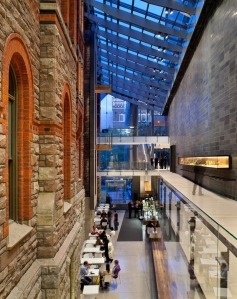
Ireland: “Adaptive reuse A NEW PURPOSE FOR OLD BUILDINGS Latham Architects – Is a building in the hand better than two in construction?” Yes!–Irish Sustainable Building.
In Minneapolis, the City has consistently taken the opposite course, approving wrecking permits for perfectly good buildings so that developers can maximize profits. On August 13, on behalf of the Healy Project, architects Peter Kim and Bob Roscoe presented a new idea to the Lowry Hill East Neighborhood Association’s Zoning and Planning Committee for redevelopment of the properties at 2320 and 2316 Colfax Avenue South. Their idea is offered as an alternative to the Lander Group’s proposed 44-unit, three-story apartment building that requires wrecking the historic Orth House at 2320 and the house next door at 2316.
“This design incorporates the existing two historic homes on the property. It is extremely important to the residents and neighbors of Colfax Avenue that the two historic properties be kept, rehabilitated and incorporated into the proposed design at this location. A modern blending of materials can be utilized while at the same time remaining sensitive to the nineteenth century use of wood, shingles, and decorative elements found on the original buildings. A plan that utilizes historic houses as a triplex with additional urban housing units that is sensitive to the urban fabric and to architectural language. Compared to the proposed development, this idea preserves street appearance and contains 72% of the number of proposed units. The Healy Project contends that utilizing historic buildings in this location will contribute to both the economic and cultural aspects of development in LHENA.”–Introduction to Alternate Idea for 2320 Colfax.
Roscoe and Kim’s plan provides for 32 units: 1 bedroom 18 units; 2 bedroom loft 6 units; 2 bedroom + 8 units. Total 32. It provides for 30 parking spaces: Basement 24, Off Street 6. The new apartment building is placed behind the two existing houses, which would be rehabbed and incorporated into the new housing development.
To view the plan, click here: 2320-Draft2
The first part of the Wednesday meeting was the presentation of the Lander apartment project’s most recent “tweaking”, with zoning variances, by Collage Architects. Apparently completely uninterested in any proposal involving preserving the house, after Collage’s presentation, CM Lisa Bender and all the other Lander proponents walked out of the meeting. Only Wedge developer Don Gerberding remained for Roscoe and Kim’s presentation.* It’s a sorry situation when City officials are so bound up in the same old, tired models for development that they can’t bother even to consider the new.
If the property at 2316-2320 were a vacant lot, there would be no controversy. New development would be completely appropriate. But it is not vacant land, and the houses to be destroyed, especially the Orth House, can never be replaced. (See blog post, “Greenwashing Demolition.”) When will the City stop favoring new, big apartment development, and start looking at the old buildings that make Minneapolis Minneapolis? Apparently not as long as the current City Council and Mayor are in office.
*Note: Gerberding currently has a controversial proposal in the works to redevelop the northwest corner of Franklin and Lyndale Avenues in the Wedge. The day after this presentation, an article in the Minneapolis Star-Tribune reported that Gerberding has defaulted on a $400,000+ loan from the City from 2008, and the City is looking into suing him.
–T.B.
Demand that Minneapolis, the “Zero Waste” City, allow the ordered designation study for the historic Orth House to be done.
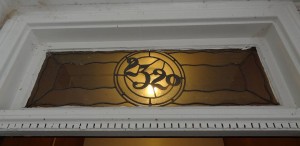
Last week the Minneapolis Zoning and Planning Committee, after listening to an hour of testimony, voted on a motion from CM Bender (Ward 10) to approve the owner’s appeal to demolish the Orth House, 2320 Colfax Ave. S. Lisa Goodman (Ward 7) was the lone dissenter. This vote overturned the decision of the Heritage Preservation Commission to allow the house interim protection (180 days) while a designation study is done. CM Bender must be called to account.
Last year the HPC declared the house to be an “historic resource” and the City Council unanimously upheld this decision. The owner, Michael Crow, and developer, Michael Lander, came back to the HPC this year, saying a designation study hadn’t been done and asking again for a permit to demolish an historic resource. The HPC reaffirmed their previous decision, and ordered a study.
Why wasn’t a designation study done? So far, we have no answer. The issue before the City Council is whether or not viable alternatives to demolition exist for the house. Ignoring the testimony of experts like architect John Cuningham (whose firm did the Uptown small area plan) and structural specialist John Jepsen, who both examined the house inside and out, CM Bender based her opinion on the testimony of those who would reap substantial financial gain from the house’s demolition: the owner, his broker, and the developer.
CM Bender declared that it is not feasible to rehab the house as a single-family home. No one testifying suggested that option, focusing instead on the need for affordable multi-family housing in the city. The owner, Michael Crow, declared that he has spent $250k on improvements to the house. City inspections records show that he spent less than $24k. Last year Crow’s broker, Tom Dunne, when asked directly if he marketed the property on residential MLS, said yes, but admitted this year that he has not. Is the Minneapolis City Council simply going to accept the claims of the owner and broker as fact? Shouldn’t all allegations by appellants be fact-checked by the City?
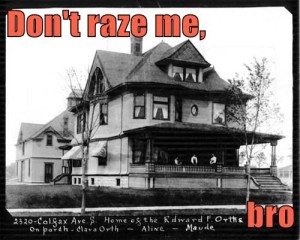
The City Council should not be taking the word of the owner or developer, or anyone else, on faith. Unless the designation study is done, we have no way of knowing who is giving an accurate, fact-based assessment of the house. Since the vote last year, nothing has changed with the condition of the house or the City ordinances governing historic resources. Ask the CMs on Z&P who voted to grant the house protection last year to justify their change of position (Kevin Reich 1, Barbara Johnson 4). Ask the other CMs who voted last year to follow correct procedure and allow the designation study to go forward (Cam Gordon 2, Elizabeth Glidden 8, John Quincy 11). Copy Mayor Betsy Hodges, who served as CM Ward 13 last year. Ask the new CMs to let the study proceed. Send an e-mail to CM Goodman, thanking her for her support.
Let the City Council’s decision about the Orth House be based on verifiable facts, not the appellants’ unsupported allegations.
The full vote of the City Council on this motion will be held, without public hearing, on Friday, April 25th, at 9:30.
Contact city council members NOW and ask that the City follow correct procedure and allow the designation study to be done. Keep your message short and to the point. Request a response. For a list of current Council members, see http://www.ci.minneapolis.mn.us/council/
 _________________________________________________________
_________________________________________________________
What the facts are:
Re: Sustainability. While the City is touting its “Zero-Waste” initiative, City Council is heading towards approving the demolition of a sound, historic house, sending 180+ tons of materials to the landfill. The City and the developer are using “trickle-down” sustainability, putting the responsibility on the project’s residents, who are expected to sell their cars, bike, use public transportation, and recycle.

Minneapolis, the Zero Waste city, wants us to recycle and ride bikes–while the City sends hundreds of tons of historic houses to the landfill.
Re: Density. The developer claims that his so-called “Eco-flats” will provide needed density on transit hubs, a goal of the City Planning Dept. Density and transit hubs already exist in the Wedge. These amenities are there now, new development or not. The population of the Wedge is being increased by 47% by new development along the Greenway. How much density can the neighborhood absorb?
Re: Neighborhood support. The Lowry Hill East Neighborhood Association does not support the Lander development. A motion to approve the project did not pass the board. A survey of e-mails to the City regarding this issue shows overwhelming support for the house by residents with addresses in the Wedge.
Re: Affordability. Rent in new buildings, to be economically feasible for the developer, must be set at market rate or higher. The 1,800 new units in the Wedge are luxury housing. The Lander project will bring more gentrification, marketing to affluent white people. The affordable housing is the existing houses and apartments, not new construction. A perfect site for an apartment project is available at Franklin and Park. Why doesn’t the City urge Lander to build there, rather than facilitating the wrecking of an historic resource?
Re: Preservation. As noted in the 1981 article in Twin Cities magazine, 2320 Colfax is the transitional design in the career of celebrated master builder Theron Potter Healy. The Heritage Preservation Commission determined that the house is an historic resource. But the City thinks historic houses are worth saving only if they are in “good” neighborhoods. As CM Goodman observed, “This house will see an untimely death as a result of its location. If this was in Lowry Hill or Kenwood we would not be having this conversation.”
STOP DEMOLITION
Ask CMs to pay attention to the presentation of these facts at Z&P last week. Demand that the City follow protocol and allow the study ordered by the HPC to be completed.
Council Members by Ward:
1. kevin.reich@minneapolismn.gov, 2. cam.gordon@minneapolismn.gov, 3.jacob.frey@minneapolismn.gov, 4. barbara.johnson@minneapolismn.gov, 5.blong.yang@minneapolismn.gov, 6.abdi.warsame@minneapolismn.gov, 8.elizabeth.glidden@minneapolismn.gov, 9.alondra.cano@minneapolismn.gov, 10.lisa.bender@minneapolismn.gov,11. john.quincy@minneapolismn.gov, 12.andrew.johnson@minneapolismn.gov, 13. linea.palisano@minneapolismn.gov
Thank Lisa Goodman for her support 7.lisa.goodman@minneapolismn.gov
This Healy house, a design descendant of the Orth House, is on Lowry Hill.
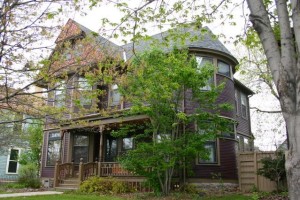 |
| 3139 Second Ave. S, the second house Healy built (1886, $3,500) |
To receive notices about future tours and events, e-mail info@healyproject.org.
+ + + + + + + + + +
The Healy Project is celebrating its incorporation as a nonprofit with a tour of the Healy Block Historic District on Sunday, November 10th.
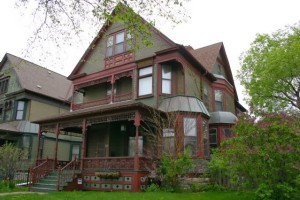 |
| The Rea House in the Healy Block Historic District (1890, $5,000) |
Motorists exiting northbound I-35W at Lake Street can’t help but notice the Queen Anne houses on Second Avenue, arguably the best known Victorian houses in Minneapolis. These fanciful survivors from a bygone era were designed and built by Theron Potter Healy, Minneapolis’s premier master builder. The entire west side of the Second Avenue block was wrecked in the 1960s during freeway construction. Over the years, fires, poor maintenance and redevelopment have taken others.
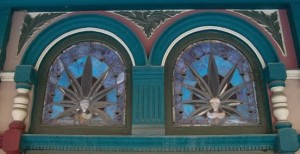 |
| Healy’s signature double-arch windows. |
Built between 1885 and 1898, these surviving houses, listed in the National Register of Historic Places, have endured thanks to the efforts of a small, but dedicated community. On Sunday, November 10th, the Healy Project is offering a different kind of home tour showcasing the community that has served as advocate for the houses of the Healy Block Historic District (3100 block of Second and Third Avenues).
The Healy Project’s inaugural tour aims to highlight and support the efforts of this community. Tourgoers will not only get the usual background into the houses’ architecture and history, but also background on the economic, cultural, and political forces affecting their past and future. Experts on real estate, community action, and historical research will talk about architectural preservation in the contemporary, living city.
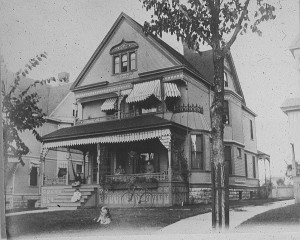 |
| 1890’s photo of the J.B. Hudson House (1890, $6,000) |
Preview of tour attractions: Background about the history of the Block and the struggles of homeowners in the neighborhood. The context of the Block in the Central neighborhood. A look at so-called “Undercover” Healy block (3200s Second Avenue), contrasting the houses there with the protected houses in the historic district. Healy homeowners’ success at saving other houses on adjoining blocks from demolition. An explanation of how a large Healy carriage house was lifted and replaced on its foundation. A look inside three early Healy-designed Queen Annes (built 1886, 1890 and 1891) on the Block. Information about a MnDOT plan that seriously threatens the entire Block. And more!
 |
| Theron Potter Healy, King of the Queen Anne |
Registration is required to tour house interiors.
Tour-goers should assemble in front of 3139 Second Avenue South at 1 p.m. on the 10th. If you would like to see the interior of 3139, come earlier. Doors open at 12:15 p.m. A $10 donation to the Healy Project is suggested.
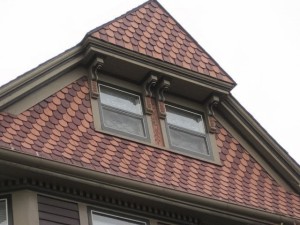 |
| Fishscale shingles on the gable end of 3139 Second Ave. |
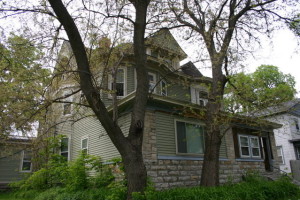 |
| The Orth House, 2320 Colfax Avenue South |
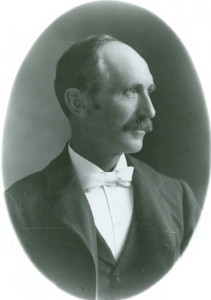 |
| Theron Potter Healy |
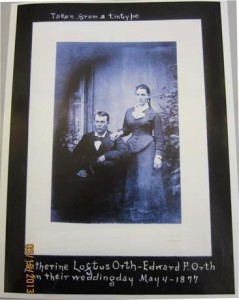 |
| Edward and Catherine Orth, first owners of 2320 |
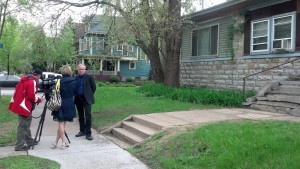 |
| Anders Christensen being interviewed in front of 2320 by KARE-11 TV reporter Lindsey Seavert after the Z&P appeal hearing May 21st. |
Answer: The one standing.
So says Carl Elephante, Director of Sustainable Design at Quinn Evans Architects. Last year, the National Trust for Historic Preservation released a study, “The Greenest Building: Quantifying the Environmental Value of Building Reuse,” with data that supports this contention. The report uses Life Cycle Analysis (LCA) to compare the relative impacts of building renovation and reuse versus new construction. The description of the study says that it “examines indicators within four environmental impact categories, including climate change, human health, ecosystem quality, and resource depletion.”
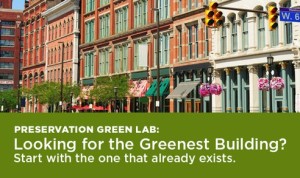 |
| copyright, National Trust for Historic Preservation |
According to the study, wrecking a building and replacing it with a new one comes with very high environmental and economic costs. Let’s look at what how these costs apply to the wrecking of the historic Orth House at 2320 Colfax Ave. S.in order to build the Lander Group’s new four-story apartment building:
First is the cost of destroying the existing structure. Wrecking the Orth House (and its neighbor at 2316) will cost the developer approximately $30,000 each. Add to this cost, the waste of the building materials of the house. The Orth House, a large 6,000+-square-foot house, is estimated to weigh 180 tons, not including the foundation (John Jepsen, Jepsen, Inc.). The Orth House was built in 1893 of lumber from Minnesota’s virgin forests. This irreplaceable resource will be hauled off to a landfill, never to be used again. The plaster, lath, windows, and mechanical systems will similarly be trashed. Yes, some of these features could be removed for salvage; however, the sad fact is that staircases, doors, and windows in a house of this size and vintage cannot easily be fitted into an existing structure. To reuse them, one would have to custom build a structure they could fit into. And what’s the point of that when they are already serving their purpose in the existing house?
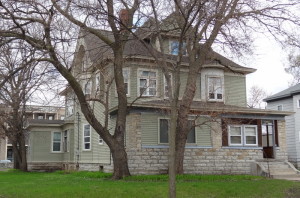 |
| The Orth House today. |
Second is the cost in labor and materials to build the new structure. New construction consumes many resources. The developer’s claim about energy savings makes no sense because new construction consumes so much energy upfront in producing new materials. (U.S.Green Building Council) The proposed apartment building is not one that uses a variety of “green” features and technologies, but a run-of-the mill structure. Recycling bins and bicycle racks do not a green building make. In fact, according to the Trust’s study, when replacing an average existing building with a new, more efficient building, it still requires as many as 80 years to overcome the impact of the construction.
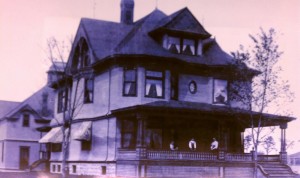 |
| The Orth House c. 1900 |

Recycling existing buildings is essential to creating sustainable cities.
Minneapolis, do the right thing: Support sustainability and save the historic Orth House from the landfill.
–T.B.
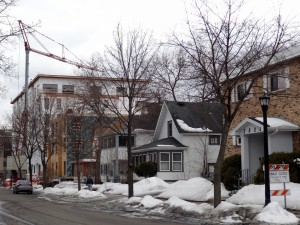 |
| The west side of the 2800 block of Colfax Ave. S in the Greenway: a 1970’s 2-1/2-story walkup, three modest-sized houses, and two apartment buildings under construction. |
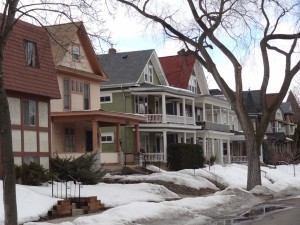 |
| The west side of the 2600 block of Colfax Avenue S: two large 1960’s apartment buildings and turn-of-the-century houses |
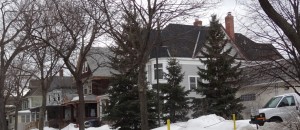 |
| The west side of the 2300 block of Colfax Avenue S: the back of the funeral home parking lot and four 1890’s houses, three of them built by T.P.Healy, all currently rooming houses. |
 |
| Doomed by redevelopment? The Edward Orth House, 2320 Colfax, one of two houses developer Michael Lander intends to demolish for a four-story apartment building. |
 |
| The Wedge (when it wasn’t the Wedge) under development as a streetcar suburb in the 1890s, as seen from Lyndale Avenue. |
One of the boasts of contemporary urban planners is that high density brings to the city a variety of benefits, such as energy savings, public transportation, and a boost to the local economy and city tax coffers. The four-story Lander development that seeks to replace the two houses at 2316-2320 Colfax Avenue is a harbinger of higher density in the apex of the Wedge. This increased density will have a long-term impact on livablility in the neighborhood. While it is true that higher density can mean a more efficient use of resources, it can also bring social ills, such as the displacement of tenants of limited means and families with children, as well as the destruction of community identity.
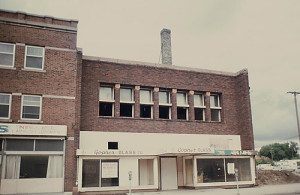 |
| The Hegg Building, Purcell and Elmslie, 1915, demolished for K-Mart, 1980. An example of thoughtless redevelopment. |
I have lived in Lowry Hill East since 1976. The ‘Seventies witnessed an ongoing struggle between Wedge residents trying to make this an attractive place to live and the forces of urban decay–prostitution, drugs, delinquency, and heavy commuter traffic. Most of the new homeowners were attracted to Wedge houses because: 1) real estate was relatively inexpensive, 2) the old houses had architectural charm, and 3) a lively, politically savvy community had taken root in the form of LHENA.
But even though LHENA accomplished much at City Hall (partial downzoning and traffic reduction for two), individuals as well had to step up and do battle. One example was on my block of Emerson Avenue. In the early 1980s, an old couple cashed out their duplex two doors down from my house to a slumlord. The duplex became a drug warehouse, with more than 20 unrelated people inhabiting the lower unit. Taxis and cars pulled up at all hours of the day and night, picking up packages. Drugged out tenants harassed all their neighbors with rude comments and raucous behavior. My next door neighbor at that time was an IRS agent, completely unfazed by having to work his way through multiple levels of government. It took a whole year, but one day Minneapolis SWAT turned up and hauled away the drug warehouse people in the duplex, and the slumlord became the target of an IRS audit.
 |
However, most of the battling was done by homeowners in the northern R-6 part of the Wedge, the higher density area. To protect themselves, their families, and property, homeowners monitored badly managed apartment buildings and rooming houses, calling in the police and City housing inspectors.. But often, City agencies weren’t able to stop the problem, forcing residents to act on their own. In one memorable case, a two-and-a-half story walkup on Bryant Avenue had become home to prostitutes who had frequent noisy nocturnal customers. One of these guys showed up like clockwork on weekends, creating a disturbance in the wee hours of the morning each time. After a number of strategies failed to stop him, one night the owner of the house across the street got in his car and followed the John to his home in Golden Valley. There the homeowner confronted him with the news that if he, the John, ever made a disturbance in the Wedge again, the homeowner would be coming out to tell his wife and children of his activities. The John was never seen again.
Through these and similar heroic efforts, the homeowners of the Wedge, along with their allies among renters and landlords, have made Lowry Hill East one of Minneapolis’s most desirable places to live and work. In so doing, they have made considerable investments of time and capital. However, with the proposed displacement of two houses by a new apartment complex, it seems that the neighborhood is becoming a victim of its own success. Lander has redeveloped the southern Greenway part of the Wedge into many apartment, townhouse, and condominium units. Now Lander, along with the City, is planning to start the redevelopment of the apex into another high density area. Have these homeowners fought this long battle to save the neighborhood and its houses, only to be exploited and ultimately driven out by the City?
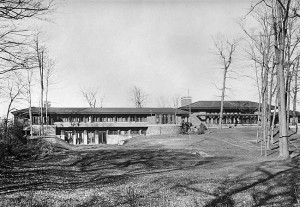 |
| The Francis W. Little House in Deephaven by Frank Lloyd Wright, 1912-1972. Demolition, like extinction, is forever. |
Sometimes it’s enlightening to see one’s neighborhood through the eyes of outside observers. On one dark November evening last year, I took a shuttle from the airport to my house. I was the only local resident aboard the shuttle; the other eight passengers were business people headed for downtown hotels. Despite my request to stop, the driver overshot my house by about a half block. As I tried to exit the van, the other passengers insisted that the driver back up to let me off directly in front of my house. Why? To them, the place looked very scary, and they were sure I’d be in danger out on the street. As I clambered from the back seat to the door, I tried to assure them that I would not be mugged on my way to the corner. But it was no use. People see things through the filters of their preconceived notions and experience. To them, this was the old inner city, alien and terrifying. I’m sure some of them would have been all for razing the entire neighborhood and building shiny new glass, brick and metal condos and apartments in its place.
This kind of skewered view of the neighborhood is one of the reasons that I am not impressed by the arguments for higher density by those who live in low-density neighborhoods of the city. As one who has lived in the Wedge for 36 years, I’ve seen the attempts to remove “urban blight” first through the building of small walkup apartment buildings, and now, through the construction of apartments and condos for the affluent.
The Wedge already has its fair share of high density housing in the Lander Greenway developments and the apartment buildings on and near Hennepin and Lyndale Avenues. Those who want higher density in the apex would be more convincing if they themselves lived in high density areas. Put your money–and home purchases–where your mouth is. Only those who have homes in high density areas can understand the day-to-day trials and challenges: the traffic snarls, snow emergency melees, street noise, loud parties, drunken revelers, etc. As density increases, such areas become less attractive to families, who understandably prefer to raise their children in neighborhoods of single-family homes.
As an election judge in 10-2, I got to see hundreds of my neighbors–people who stood in the cold and rain for an hour or more to exercise their right to vote. Young and old, gay and straight, professional and blue collar, handicapped and able, affluent and poor, married and single, native-born and naturalized, of all colors and races–they represent what makes the Wedge a great place to live.
I say again, if 2316 and 2320 are wrecked for the four-story Lander apartment building, it will be the harbinger of more of the same. Density doesn’t always mean diversity. Keep tearing down houses for condos and apartment buildings and inevitably some groups will start disappearing from the mix–families, old folks, people of modest means.
If the Lander project goes forward, it will send a clear signal to those who hope to redevelop Lowry Hill East into a high density Eden: Gentlemen, start your bulldozers.
Next: Theory and Practice in Urban Planning.
–T.B.
In 1980 when then-Wedge-resident Anders Christensen examined the building permits for all the houses in Lowry Hill East, he discovered that a master builder named Theron Potter Healy had built 30 of them. Further research revealed that during his career (1886-1906), Healy had built over 120 houses and commercial buildings in Minneapolis.
In 1993 Healy’s most celebrated creations, the Queen Annes of the 3100 block of Second and Third Avenue South, received national historic designation as the Healy Block Historic District. In 1977 Healy’s Bennett-McBride House had been listed on the National Register of Historic Places as a superb example of the Queen Anne architectural style.
During the first Wedge Zoning and Planning Committee meeting on the Lander Group’s redevelopment plans for 24th and Colfax, architect Pete Keeley said he had contacted the City, and they had said the two houses slated for demolition had “no historical significance.” At the second meeting, another man supporting owner Michael Crow alleged that the Minnesota Historical Society, too, had said that the Healy house at 2320 was not historically important. I’m sure that both claims are true: Neither the City nor M.H.S. have anything on record about either house.
None of Healy’s Wedge houses have received historic designation, but that does not mean that they are not historic or architecturally significant. Many historic buildings have not received official historic designation (through the Historic Preservation Commission or the National Trust, for example), but that in itself does not speak to their importance.
Consider, for example, the Wedge’s own “Healy Block”, the 2400 block of Bryant Avenue South. Eight (probably nine) houses on this block are Healy’s: 2401, -05, -09,(-10),-20, -24, -28, -36, and -39, ranging in style from Queen Anne to Colonial Revival.
 |
| 2439 Bryant, Colonial Revival, 1905 |
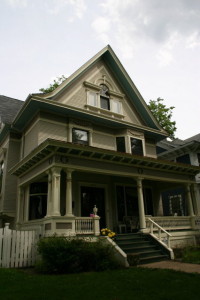 |
|||||||||||||
| 2409 Bryant, Queen Anne, 1895 |
On Bryant Avenue north of 24th Street (in the R-6 zone) are four other Healy houses; three of these are currently rooming houses. None of the houses on the 2400 block are rooming houses, although half of them were at one time. Former residents have told stories of tenants riding motorcycles up staircases, drunken brawls, drug deals, even murders taking place in these houses. Yet today, with the investments in time and money of their owner-occupants, they have become beautiful and valuable homes.
2320 Colfax, the Healy house slated for demolition, represents a pivotal point in Healy’s career. It is one of only two houses built by Healy in 1893. The other 1893 Healy house, 821 Douglas Avenue, was wrecked in 1981 by developer Paul Klodt. 1893 is a significant year in the history of architecture, the year of the Chicago World’s Fair. In this year the Queen Anne style began to fall out of fashion, replaced by the Colonial Revival style, made popular by the Fair’s “White City”. 2320 is Healy’s first Colonial Revival house, a significant part of his architectural legacy.
An old photo of 2320 reveals the original appearance of the house, with a large barn in back, and open field to the north:
 |
| The Orth House, 2320 Colfax, as it appeared when new. |
 |
| The house today. The porch has been enclosed, but the original roof line, profile, and fenestration remain. |
Obviously, some people don’t care diddlysquat about history or architecture, and this blog is not addressed to them. I have learned a very important lesson from my service on the Minneapolis Heritage Preservation Commission and the Advocacy Committee of the Preservation Alliance of Minnesota: Governments and institutions are not concerned with saving buildings. Communities must define and speak out on what’s important to the community–and work to preserve it.
The 2004 LHENA Zoning Task Force clearly articulated what is important to Wedge residents, that is, ensuring the livability of the neighborhood by preserving the current mix of houses and multiple-unit buildings. Michael Lander has already redeveloped the southern part of the Wedge along the Greenway with high density apartment buildings and condominiums. This redevelopment makes sense in that it replaced a defunct industrial area. But the apex of the Wedge is a different story. Development supporters have made much of the idea of saving the neighborhood “core”, while keeping the “fringe” high density. Truth to say, the apex is such a small area that most of it can be considered “fringe” of the greater neighborhood, the current view from City Hall. The point is moot: R-6 allows high density throughout, so-called “core” included.
Last month a first in a series of meetings was convened by the City to look into the feasibility of establishing “conservation districts” in Minneapolis. Such districts would offer more protections than the zoning code, but fewer than those of historic districts, such as the Healy Block. A conservation district would certainly be a big step forward in saving the houses in the apex of the Wedge, but the idea is only at the beginning of a long planning process, with no guarantee it will be adopted.
 |
| “360 Degrees of Wedge Healys”–Photo art by Richard Mueller |
In conclusion, I want to stress that if you want to save 2320 Colfax and preserve the other houses in the Wedge, don’t expect City Hall or an historical society to do it for you. Property rights are held sacrosanct in this country, and owners can wreck properties on the National Register if they so choose. Case in point–the developer in Arizona who wants to demolish a house designed by Frank Lloyd Wright. Despite a firestorm of outrage and temporary stay of demolition from the City of Phoenix, the developer is still determined to take it down.
Former Zoning Task Force member Sue Bode said at the first LHENA hearing about the 2316-2320 plan, “Taking down a Healy house is like destroying one by Frank Lloyd Wright.” If you care about Healy’s legacy, if you care about the old houses of the Wedge, speak out.
 |
|
| CAN PREVENT DEMOLITIONS! |
–T.B.


